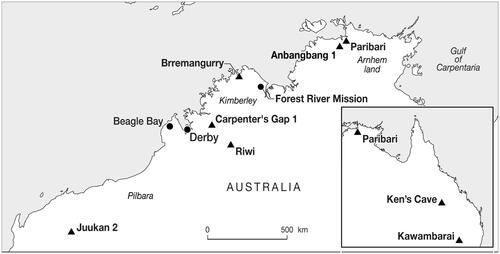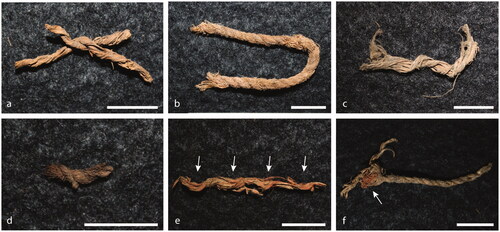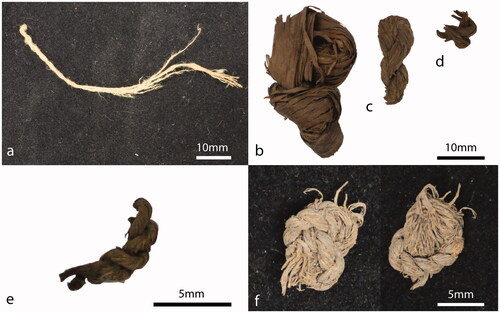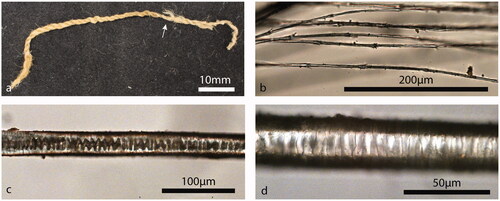Abstract
The extent to which fibre technology was used in the past is difficult to assess because soft organic remains rarely preserve well. The oldest direct evidence for twisted fibre cordage is dated to between 41 and 52 ka in western Eurasia but indirect evidence suggests that it may have a much greater antiquity. The diverse use of string made from fibres of plants, animal and human hair by Indigenous Australians is well documented but poorly represented in archaeological sites. No fibre remains have been recovered from Pleistocene contexts and they are only rarely recorded in later deposits, usually as isolated fragments. Nineteen pieces of twisted fibre recovered from deposits in two limestone caves, Carpenter’s Gap 1 and Riwi in the southern Kimberley, are made from a variety of raw materials and manufacturing techniques. These same techniques and raw materials are documented in anthropological and historical records and in museum collections, demonstrating a continuity of spun fibre practice from the Mid-to-Late Holocene to the present. A comparison of the archaeological twisted fibres with Kimberley objects incorporating string held in the Western Australian Museum, provides further insight into the technology used by Indigenous Australians before the arrival of Europeans.
Introduction
The oldest published direct evidence for twisted fibre is a fragment of three ply cordage found adhering to a Levallois flake recovered from deposits dated to between 41 and 52 ka from the site of Abri du Maras in France (Hardy et al. Citation2020). Other objects, such as perforated shell, may imply the use of string. Shell beads and pendants have been found in Middle Palaeolithic sites in north Africa (d'Errico et al. Citation2009), Middle Stone Age sites in South Africa (e.g. d'Errico et al. Citation2005; Vanhaeren et al. Citation2019) and from Cueva Anton on the Iberian Peninsula where the context is thought to date to ∼115 ka (Hoffmann et al. Citation2018; Zilhão et al. Citation2010). However, these beads and pendants may have been just as easily suspended by sinew or a length of unprocessed, untwisted plant (such as a reed). More convincing, but indirect, evidence for string are the impressions of fibre in clay recovered from Upper Palaeolithic sites in the Czech Republic, Russia, France, and Germany (Adovasio et al. Citation1996; Soffer et al. Citation2000).
Twisted fibre is an important technology in all known human societies and may have ‘helped to shape the world’ (Hardy Citation2008:271). In places with very good preservation, fibre artefacts can be recovered in greater numbers than stone artefacts (see Soffer et al. Citation2000). However, the poor preservation of plant materials other than in exceptional conditions, such as water-logged environments and very dry caves, means that the evidence for fibre technology is rare. Furthermore, as women are more often associated with the manufacture of fibre artefacts than men, this poor preservation of plants has led to biases in interpretation of subsistence and gender roles and status (Adovasio and Dillehay Citation2020; Soffer, Adovasio and Hyland Citation2000; Soffer et al. Citation2000; Soffer and Adovasio Citation2004).
In a series of papers with various colleagues, Adovasio (initially Adovasio Citation1977:vii) has argued for the importance of fibre technologies for the successful colonisation of the New World. This argument is supported by many examples of early finds of cordage and fragments of a variety of fibre craft objects (see Adovasio and Dillehay Citation2020). One of us (JB), has argued, largely based on indirect evidence, that the successful colonisation of Sahul, perhaps as much as 65 ka ago (Clarkson et al. Citation2017) relied on the presence of fibre technology (Balme Citation2013). However, unlike the Americas, conditions for the preservation of fibre are rarely present in Australian sites.
While fibre is represented in imagery in many rock art sites across northern Australia either as objects or as prints (e.g. Miller Citation2021; Moore et al. Citation2020; Veth et al. Citation2018) and there are reports of string and fragments of fibre objects found cached or on surface deposits in some northern sites (e.g. Clarke Citation1987:139; Gunn et al. Citation2017:183–185; Morwood Citation1984:542), excavated spun fibre (a series of overlapping individual fibres spun together to form a continuous piece of string or cordage), is very rare. Apart from the fibres reported here, we have only found six sites from which spun fibre has been recovered – four of which are in northern Australia.
The largest assemblage comes from Holocene deposits in Anbangbang I, a sandstone rockshelter in Arnhem Land (), where 65 finds of single segments and seven bundles of string, including one example of netting were recorded (Clarke Citation1987:157). Some of the pieces have knots (Clarke Citation1985:Figure 5.6). The string is made from bast, fur and hair fibres, and is variably two, three, and four ply (Clarke Citation1985:90). The antiquity of these string pieces is difficult to ascertain. The analysis presented in Clarke (Citation1985:Table 5.5), which was later superseded by a more detailed analysis (Clarke Citation1987), initially reported only 35 pieces of identified string. This suggests that at least nine of the 35 were found on the surface of the deposit, and all pieces were recovered from the upper units of the deposit that date to the past 1,000 years (see Clarke Citation1985:98). However, Clarke (Citation1987:157) argues that the string derives from both the surface and ‘throughout the occupation deposit’. Jones and Johnson (Citation1985:57) say that ‘human occupation occurred at a time period unknown but considerably in excess of 6 kyr’. Finally, Allen and Brockwell (Citation2020:147), who studied the wooden artefacts from the site, specify that the organic remains are confined to the most recent 1,000 years.
Two pieces of rolled spun plant fibres were also recovered from ‘the top level’ of Paribari, another sandstone shelter in Arnhem Land (Schrire Citation1982:66). Two four-centimetre-long pieces of ‘braided’ human hair are reported to have been recovered from Holocene deposits in Juukan 2 rockshelter in the Pilbara (Reynen Citation2019:159). A fragment of two ply string made from plant material, about 1.5 cm long and adhering to a small piece of quartzite, came from deposits dating to the past 500 years at Brremangurry, a sandstone shelter site in the northwest Kimberley (Mark Moore, pers. comm. 2021). Two pieces of string are preserved in the dry, late Holocene sediments of Ken’s Cave in the Central Queensland highlands (Morwood Citation1981:10). Further south, in the dry and protected deposits at Kawambarai, a sandstone rockshelter near Coonabarabran in central New South Wales, several pieces of knotted spun and unspun fibre were found on the surface (Beck and Dotte-Sarout Citation2013), and at least three spun pieces were recovered from the excavation. All of these are made from plant fibre. One is two ply and knotted with a half hitch. It was found in the top excavation unit above a date of 761–498 cal BP. Below this, but above a date of 2,310–1,619 cal BP, are a two ply fragment and one ply fragment both made from bark fibre (Wendy Beck, pers. comm. 2021).
This study reports the presence of 19 fibre fragments recovered from Holocene deposits from Riwi and Carpenter’s Gap 1 in the southern Kimberley of northern Australia (). These finds add to the growing Australian fibre assemblage and provide an insight into the diversity of raw materials used in fibre production and some of the uses to which fibre was put in pre-European contact times.
Use, raw materials, and manufacture of string by Indigenous people in the Kimberley
Use of string by Indigenous people in the Kimberley
The versatility of spun fibre is revealed in the great diversity of its uses by Indigenous Australians. A range of these — including dilly bags, baskets, handles for bags made from woven plant strips, hunting and fishing nets, eel traps, rope for harpoons, sewing thread, binding objects, and strands for suspending ornaments — are illustrated in Philip Clarke’s (Citation2012) volume. The variety and purpose of these and other objects varies substantially across the continent.
The Western Australian Museum (WAM) has an extensive collection from the Kimberley, including balls of string and objects in which string is a component. These include ornaments that are bound with ochred string, headdresses and objects made for ceremonies that include wood, feathers, and bark, pendants with pearl shell suspended by string, neckpieces or ornaments formed from string with shells, kangaroo lower incisors and, in one case, a Zygomaturus trilobus tooth embedded in resin (Akerman Citation1973). Akerman (Citation2018:215) provides references to similar objects referred to as charms, belts, armbands, or neckpieces with or without tassels made from animal fur string, including one with a dingo tail, and for stringing beads. String is used to tie packages, bind pegs to spear throwers, to bind split wood used to haft stone (or shell) axe heads, and sometimes to secure the axe head position on the handle to prevent slippage, and as handles for woven baskets and bark buckets. Headbands made of bark and secured to the head with string are also included in the collection (e.g. WAM 352, collected at Mowanjum) as are pleated bark containers with their ends secured by string.
String was also used in conjunction with other objects for everyday activities, for example, as an aid to seed grinding. Crawford (Citation1982:9) records that Kalumburu people put three or four strands of string around the periphery of the anvil stone used to crush seeds to prevent the seeds flying off onto the ground.
Despite the wide variety of uses of spun fibre in the Kimberley, apart from two recent dilly bags, one bought from an art shop and one from Oombulgurri on the Forest River (which may have been traded in), there are no items in the WAM collection made from netted string and there is very little evidence in the literature for knotted string netting being made. In fact, early written records remark on the absence of netting. Love (Citation1936:99), for example, observed in the early 1930s that the Worrorra make string but no nets. Davidson (Citation1933:261) noted the absence of knotted or looped ‘netting’ baskets in northwest Australia. However, Davidson’s (Citation1933:258) distribution map and notes on knotted and netted objects in Australia records a fishing net from Beagle Bay being in the WAM collection. A search of the museum collection found no nets from this area. However, one net from the Pilbara has ‘(BB)’ written on the label in pencil (Moya Smith, pers. comm. 2021) and it is possible that Davidson had interpreted those letters as indicating that it came from Beagle Bay. Satterthwait’s (Citation2010:34) thorough review of hunting with nets in Australia found no evidence of their use in the Kimberley and he remarks upon the absence of net hunting in the seasonally reliable habitats of northern Australia. Kaberry (Citation1939:163) says that dilly bags were made by ‘weaving’ and, although she does not say whether these were woven with spun fibre or plant strips, it is assumed that, like those in the Western Australian Museum, it was the latter.
This lack of netted goods is peculiar considering the importance of such goods in adjacent geographic areas. In the Pilbara region to the south, nets made of spinifex were used for hunting and for fishing (Clement Citation1903; Withnell Citation1901). Bates (Citation1985:248) also notes the manufacture and use of nets made from spinifex for fishing and trapping and for fibre bags for storage and transport in the Pilbara. East of the Kimberley net hunting is not recorded in northern Australia (Satterthwait Citation2010) but fishing nets and netted dilly bags (made by knotting or looping) are important parts of the technology (Davidson Citation1933).
The absence of netted objects in the Kimberley is also curious in the context of their representation in some of the Kimberley rock art. Some images clearly show the netting construction (Veth et al. Citation2018:Figure 5). Gwion Gwion figures have recently been dated to about 12,000 years ago (Finch et al. Citation2020) and are often depicted with netted dilly bags and other accoutrements (see Veth et al. Citation2011).
Raw materials for string making in the Kimberleys
In 1974 one of us (KA) recorded Worrorra people at Mowanjum in the west Kimberley, using the inner bark of both kurrajong (Brachychiton spp.) and boab (Adansonia gregorii) trees to make string, as well as human hair and animal fur. He also reports that fur for string was taken from female macropods – usually agile wallabies, and that the very fine fur fibres are taken from female possum.
Moya Smith, who worked with Bardi people of the west Kimberley to record economic plants, records string being made from the aerial roots of Ficus virens (Smith and Kalotas Citation1985:329) and the vine of Gymnanthera nitida – now known as G. oblonga (Smith and Kalotas Citation1985:338), with ‘strong string made from Brachychiton diversifolius’ (Smith and Kalotas Citation1985:339). The bark of Acacia tumida was used to make short-lived string (Smith and Kalotas Citation1985:352). At the Forest River Mission (now Oombulgurri) in the northeast Kimberley, Kaberry (Citation1939:163) records string being made from ‘certain kinds of gum trees or the ‘boababs’ as well as from kangaroo and possum fur’. Love (Citation1917:26) also noted string being made from the inner bark of several species of eucalypts or boab as well as from hair or kangaroo fur but says that only the fur of female kangaroos was used as it is softer than the male (Love Citation1917:27).
Crawford’s (Citation1982:34) records of traditional plant uses in the Kalumburu area list Brachychiton spp., B. paradoxum, and B. diversifolium bast, including the root bast, being used to make string. This is supported by a handwritten note found in the Western Australian Museum on a visit to the museum collection in May 1979, which records the observations of Mary Pandilow (an Indigenous woman who worked with Crawford at Kalumburu), saying that string was made from both boab roots and bark. The former produced a string of a ‘reddish or pink colour’ and the latter a ‘pale flax’ colour. In the same note she said that, although boab is the most popular source of material for string today, in the past they used many plants including palm tree and Brachychiton species.
The raw material used for string in the WAM is not consistently stated, and where it is, it is mostly recorded simply as fur, hair, or fibre. When further details are added they are either kangaroo and possum fur, boab, or human hair. It is also worth noting that collection notes containing taxonomic information of plants may have been inaccurate at the time of collection and, further, that taxonomic names of plants are subject to change over time.
There do seem to be different uses of hair, fur, and plant fibre string. These differences are undoubtedly because hair and fur are not as easily procurable as plant fibre. Thus, everyday domestic objects are made from plant fibre. In the WAM collections, plant fibre is used for purposes such as handles for buckets, to tie stone axe handles (e.g. A25550, 6779) and for sewing the pleats in bark carrying dishes – although one of these (A25362) is tied with hair fibre.
Fur and hair string are more likely to be used for personal ornaments and in ceremonial contexts. In the WAM collection there are belts made from human hair and belts with animal tassels made from fur. Ornaments, such as the diprotodon object referred to above, are attached to hair, as are similar objects with kangaroo teeth (e.g. A00571). Headdresses used for ceremonies are strung with human hair (e.g. E3109) and ceremonial objects made from bunches of feathers are tied with human hair (e.g. A8485 collected in 1923) – although sometimes with plant (e.g. E6899a). Other ceremonial objects include a belt made of human hair to which groups of between three and six abalone shell rattles are attached. Neckpieces are made from fur or ochred plant fibre. Despite the ritual context, Akerman was told that hair string is not often used to secure burial bundles as it was apt to be attacked by insects.
Love (Citation1936) makes some observations that suggest there may have been some gender differences in the use of raw materials for belts. Fur string is used on children's and women’s belts. For example, Love (Citation1936:125) includes an image of a child with a belt and tassel made of kangaroo fur string, and another of three children with kangaroo fur belts, one with a pearl shell attached and two with tassels of fur string (Love Citation1936:150). A photograph shows three women with fur string belts (Love Citation1936:157), while images of men show them wearing belts made of fibre hair string (Love Citation1936:44, 45, 155, 156).
String manufacture
The manufacture of tree-fibre string in the Kimberley is usually described as being done by twisting the raw material on the thigh or lower leg. Kaberry (Citation1939:163) says that the tree fibre was soaked, beaten, then rolled on the legs. Love (Citation1917:26) refers to tree fibre being beaten before being spun on the legs but does not suggest that it was soaked first. In 1974, Akerman recorded tree fibre string making in the west Kimberley. Bark fibre is first teased out () and then the two ply string can be made in one of two ways. In one method two fibre pieces are rolled on the maker’s leg resulting in the individual fibres being twisted in a clockwise direction (). Fibres are added to the single ply string while rolling (). Two pieces are then back rolled up the leg but, as the hand moves back, more pressure is placed on the area beneath the thumb. The hand slides at an angle and the two pieces are plied together in an anti-clockwise direction forming the two ply string.
Figure 2. Senior Worrorra woman the late Gertie Yabu making tree fibre string: (a) teasing bark fibre in preparation; (b) spinning the first lengths of bark fibre on her leg; (c) adding length to the string; and (d) back spinning the two lengths of bark to make a two ply twine (Photographs: Kim Akerman, Mowanjum 1974). Produced with thanks from Mr Donny Woolagoodja and Mrs Janet Oobagooma.
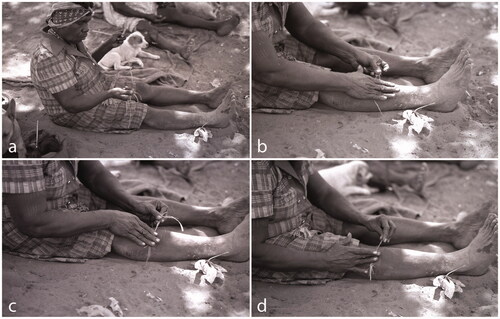
The second method is shown in . In this method a single piece of fibre is rolled on the leg. The resulting twisted string is then folded into two () and the pieces back spun up the leg to create two ply string (). Length can be added to the two ply string by splicing in further pieces of fibre ().
Figure 3. Method of hand spinning two ply fibre: (a) individual fibres are rolled down the leg; (b) the resulting fibre is folded in half; (c) spun up the leg; and (d) adding new fibre to the twist.
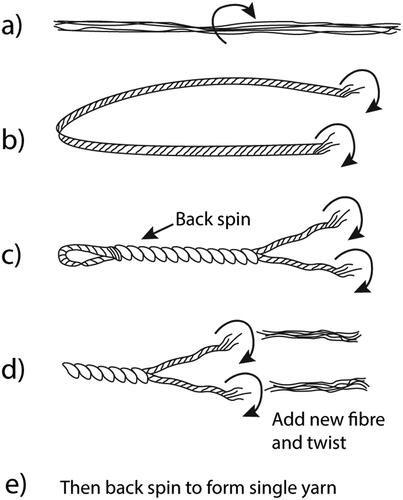
Love (Citation1917:27) says that string made from fur by the Worrorra people was spun with a spindle. In the 1970s Akerman also observed that a spindle is needed to make both fur and hair string throughout the Kimberley. Presumably the spindle was used because fur and hair are finer and recovered in shorter pieces than plant fibre. Love (Citation1917:27) records the process of making fur string in the west Kimberley; the fur is first beaten into a ‘tangled mass’ from which pieces were fed onto the spindle. The spindles that Love describes were made from a piece of stick about 30 cm long which passed through an oval-shaped piece of wood (the spindle whorl) about 10 cm long – although spindle whorls on examples held in the WAM are often one or two smoothed sticks, set at right angles on the shaft (e.g. 271, 1,416). This cross spindle appears like the ‘Turkish drop spindle’, although they are turned on the thigh with the whorls uppermost, while on the drop spindle the whorls are placed at the bottom of the shaft which is twisted by the fingers and thumb alone.
Hair must be teased out before it is fed into a spindle (). The longer piece of the stick is then rolled along the leg to twist the fibre in a clockwise direction (). Unlike the thigh method, the spindle method produces a single twisted thread that is not plied. Thus, to make two ply string, two pieces of spun thread must be spun together. Akerman’s 1974 observations of women using spindles in Mowanjum show this process (). After the hair is teased out, a small piece spun on the thigh to create a lead end is tied to the propeller (). Small pieces of fibre are continually added to the previous fibre as the spindle is spun (). When the spindle is full of single ply (), the axis of the spindle is withdrawn, and the propeller is pulled out with the first section of the ply exposed (). Proximal and distal ends of the yarn are exposed, laid side by side () and then replaced on the spindle and back spun – that is, the spindle is rolled up, not down, the thigh. This melds the yarn into a two ply strand.
Figure 4. Senior Worrorra woman May Langi using the spindle method: (a) teasing out human hair before spinning it into yarn; and (b) using a spindle to spin hair string (Photographs: Kim Akerman, Mowanjum 1974). Produced with thanks from Mr Donny Woolagoodja and Mrs Janet Oobagooma.

Figure 5. Process of spindle spinning: (a) lead end hand spun; (b) lead end tied to propeller; (c) small pieces of fibre continually added as the spindle is spun; (d) spindle full of single ply; (e) axis of the spindle withdrawn and propeller removed; and (f) proximal and distal ends of the yarn are replaced on the spindle and back spun.
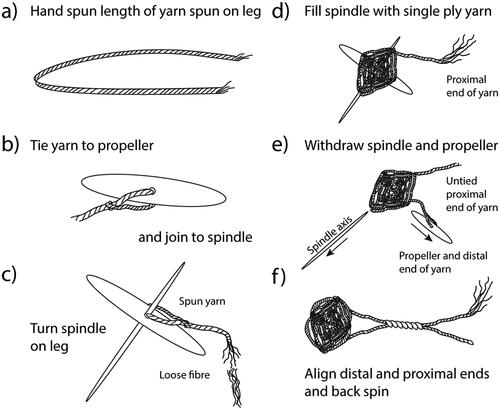
The string assemblages from Riwi and Carpenter’s Gap 1
Riwi and Carpenter’s Gap 1 (CG1) are two limestone shelter sites, about 250 km apart in the south central Kimberley (). Details of the excavation techniques and chronologies for each site are described in Maloney et al. (Citation2018) and Balme et al. (Citation2019). Both sites were first occupied by people from just after 50,000 years ago and both have evidence for continued but sporadic use to the present (Balme et al. Citation2019; Maloney et al. Citation2018). The alkaline, dry sediments have provided excellent preservation conditions with small fragments of bone preserved in the deepest layers at both sites and hard plant remains, such as seeds, nuts and phytoliths are preserved to the base of CG1 (Dilkes-Hall et al. Citation2019, Citation2020; McConnell and O’Connor Citation1997; Wallis Citation2001). Soft plants parts are also preserved in the Holocene levels of these two sites, and it is from these deposits that the spun fibre fragments derive.
A total of 19 fragments of twisted spun fibre (string) were recovered from the two sites, eight from Riwi and 11 from CG1. and summarise the location, raw material and age of the spun fibre fragments recovered from Riwi and CG1 respectively. None of the fibre fragments is directly dated and the ages given in the tables are the radiocarbon dates obtained for charcoal and OSL samples from the same stratigraphic units and from the Bayesian models created for Riwi (Wood et al. Citation2016) and CG1 (Maloney et al. Citation2018). Radiocarbon dates recovered from the same units as the string pieces, given as 95.4%, calibrated against SHCal13 (Hogg et al. Citation2013) in OxCal v.4.3 (Bronk Ramsey Citation2009) and previously published in Wood et al. (Citation2016) and Maloney et al. (Citation2018) are also listed.
Table 1. Stratigraphic, age and raw material details of twisted, spun fibre fragments from Riwi.
Table 2. Stratigraphic, age and raw material details of twisted, spun fibre fragments from Carpenter’s Gap 1. Square AA pieces were not included in the Bayesian model as the square does not join the main excavation.
Raw material identification
A lack of comparative reference material means that we are currently not able to taxonomically identify the plant species used in string production. However, it is clear from differences in fibre thicknesses discussed below that more than one plant type is represented in the assemblages.
Human hair and animal fur were identified using microscopic analysis of hair morphology developed in trichology. Each strand is formed by three concentric layers of keratinised cells; the cuticle, cortex, and medulla (Teerink Citation1991) which, when viewed microscopically, show patterns and specific morphological traits that can be used for taxonomic identification. For animals, outer and thicker coat of hairs (overhair), and the smaller undercoat (underhairs) can be distinguished (Teerink Citation1991). Identification of hair from animal species was undertaken by one of us (BK). The morphology of animal hair present in the CG1 assemblage was compared with reference collection materials held at the Australian National University to identify mammal species. Animal fur samples were identified under transmitted light using a Zeiss EL- Einsatz 451889 Axiophot microscope with 250×, 400×, 630×, and 1000× magnification. Photo-micrographs were taken at these magnifications.
The Riwi assemblage
Six of the eight string fragments at Riwi are made from plant fibre (), with the remaining two being made of human hair (). All eight pieces derive from two ply yarn consisting of two separate fibres spun in a clockwise direction and then plied in an anti-clockwise direction. Riwi 2 () shows this clearly. The second ply is not present in two fragments – one hair Riwi 1 () and one plant Riwi 7 (). However, the kinks in the fragments suggest that they have separated from the second strand. One piece (Riwi 8, ) has a half hitch knot in it. It is possible that the four fragments from square 5 () originally derived from a single string strand. Riwi 7 and 8, in particular, probably derive from the same piece, as both have ochre on them. Riwi 7 () only has ochre on the areas of twine that would have been exposed when twisted suggesting that ochre was applied after the string was plied. Riwi 5 () has flatter fibres but this may be the result of the unravelling of end string pieces.
The Carpenter’s Gap 1 assemblage
The string fragments recovered from CG1 are more or less evenly divided between plant fibres (six) and animal hair fibres (five). Nine of the pieces consist of two fibre lengths spun clockwise that are plied in an anticlockwise direction. One (CG1/2) is single ply.
Plant string fragments
shows the six string fragments made from plant fibres. CG1/1 is a loosely plied string fragment folded over at one end suggesting that the piece was rolled without a spindle (). The looseness may indicate that the fragment was never part of a longer piece of string. CG1/2, 3 and 4 are all relatively unseparated fibres, which have resulted in thick pieces of string (). CG1/2 (), is single ply and knotted. The fibre is so wide, that the twisting was probably done with the hands only rather than rolled on the leg. CG1/3 (), has been folded before being twisted into two ply. CG1/4 (), is a smaller fragment of two ply string and it is possible that it was originally joined to CG1/3. All three pieces appear to be from the same plant source but the difference in thickness between CG1/2 and the other two fragments suggests possible different functions (although they may have derived from a single artefact). The fourth piece from square AA excavation unit 10 (), is composed of more finely teased fibre and clearly represents a separate activity. is a single piece of string with an overhand knot.
Animal hair string fragments
Three fibre pieces (CG1/7, CG1/8, CG1/9) all deriving from the same square and excavation unit, were identified as being made from the hair of Trichosurus vulpecula (brushtail possum). The hair is primarily underhair but some overhair is also present (). These pieces may have been once joined together as they were recovered adhering to one another but without being woven together. The diagnostic features are regular wave scale pattern in the shield region (), and narrow aeriform lattice medulla in the shield region (). The proximal shaft scale pattern is diamond petal (), and in the proximal section of the hair the medulla’s structure is uniserial ladder (). These features correspond to reference collection material properties (). CG1/10 () from two excavation units below these pieces was also identified as being made from brushtail possum fur. The diagnostic features are distal pigment streaks, with proximal diamond petal scale pattern (), narrow aeriform lattice and uniserial medulla (), and in the shield region the scale pattern has regular wave ().
Figure 9. Animal hair string fragments from Carpenter’s Gap 1: (a) CG1/7; (b) CG1/8; (c) CG1/9; and (d) CG1/10. Bar scale is 5 mm in all photos.
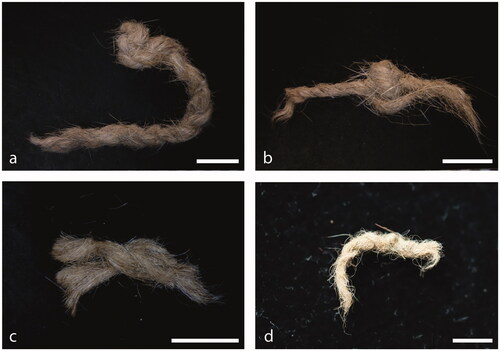
Figure 10. Diagnostic features of animal hair used to identify string raw materials from CG1: (a) shield region with regular wave scale pattern; (b) narrow aeriform lattice in the shield region; c) underhair with diamond hair scale pattern; (d) proximal section of medulla with uniserial ladder structure; (e) reference specimen of proximal section of T. vulpecula underhair (ear); and (f) reference specimen of distal section of tail hair of Trichosurus sp. showing narrow aeriform lattice medulla. Bar scale is 20 µm in all photos.
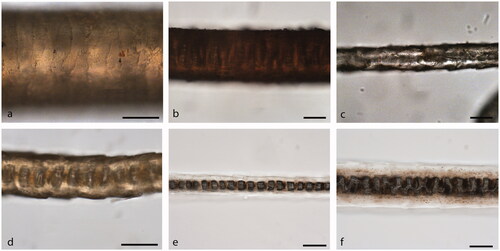
CG1/11 is made from animal hair with feather barbs () and consists of two pieces of string that have been spliced together (). The mammal hair component was identified as T. vulpecula, with diagnostic features including a medulla with narrow aeriform lattice distally/shield region (), a proximal diamond petal pattern () and scale pattern with regular wave in the distal/shield region (). The feather barbs () have a stippled node junction that is colour free, which may indicate Acciptridae (hawks, kites, falcons, and eagles).
Discussion and conclusions
From these results we can say that during the Mid-to-Late Holocene, Indigenous people in the Kimberley manufactured fibre, string or cordage from human hair, mammal fur and plant material, which were sometimes adorned or decorated with bird feathers. The presence of folds in the individual fibre strands before they were plied also suggests continuity in manufacturing technique into recent times.
At least some of the plant materials used for the string are root fibre and most of the mammal material is brushtail possum underhair. These raw materials, with the addition of human hair, suggest a continuity of string manufacturing resources into the recent past. It is perhaps surprising that all the animal hair string is made from possum fur despite macropods being more common in the assemblage during the Mid-to-Late Holocene at CG1 (Maloney et al. Citation2018:Supplementary Table E). It is possible that the fragments of possum string all derive from a single artefact, such as a tasselled belt, and the differences in thickness of the string fragments results from their different placement in the artefact. Alternatively, the explanation may lie in the relative fineness, and consequent softness of possum fur compared to macropod fur, which may have made it especially sought after. In this respect it is interesting that there are no string fragments made of fur at Riwi despite the preponderance of such remains at CG1. So far only the identification of fauna from square 3 is available and no possum remains were identified – although there is an abundance of remains from macropods of different sizes. Thus, it is possible that possum fur was difficult to obtain, if possum was indeed the prime choice for animal string.
It is difficult to suggest the purposes of the string based on these small fragments. The fact that the bulk are made from plant fibre, which is more accessible than either animal fur or human hair, indicates that as in recent times, the string was used for a wide variety of domestic goods. The presence of ochre on two of the Riwi string pieces suggests an ornamental function, but not necessarily a ceremonial function, as some hafted Kimberley points in the WAM collection have ochre on the hafting string. Other archaeological materials from CG1 and Riwi are consistent with the interpretation that these two sites were domestic campsites.
The finds also suggest that Maloney et al.’s (Citation2015:38) proposal that the hafting tie impressed in resin on a stone point from CG1 was formed by an organic fibre or string binder, is unlikely to be correct. The diameter of the impressions made on the resin hafted stone point is probably too fine, at ∼0.3 mm (Maloney et al. Citation2015:38), to be made by these string pieces, which we would expect to leave depressions more than, or around, their average diameter of 1.5 mm. This direct comparison now leads us to strongly suggest sinew as a likely product responsible for these impressions. While no such sinew survives in the CG1 deposit, use of sinew is widely documented in the region in more recent hafting of stone points (Akerman Citation2010:486; Carnegie Citation1898:340).
Both sites contain artefacts of personal adornment in the form of beads made from scaphopod shell segments (Balme et al. Citation2018; Balme and O’Connor Citation2017). It is possible that some of the string was used to string these segments, or beads made of perishable organic material such as reed, that have not survived. For example, the diameter of the string fragments, particularly those made from animal fur (between 2 mm and 0.5 mm), would have accommodated the shell bead apertures which vary from 4.9 mm to 3.5 mm (Balme et al. Citation2018:263). The very fine possum hair may have been selected to create the tasselled fur belts that Love (Citation1936) records were worn by women and children in the west Kimberley.
The pieces of human hair string at Riwi recovered from two non-adjacent excavation squares may suggest a ceremonial, or at least symbolic function, given the use of this fibre type today. However, their presence in an otherwise domestic site suggests that the string was either made in a domestic setting for later ceremonial use, or was a symbolic accoutrement that was worn in a domestic location. The fur string fragment with feather adornment from CG1 can be similarly interpreted.
It is unlikely that nets would be made of animal fur as they would disintegrate and rot when wet. None of the plant fibre fragments bears any indication that they were part of a net, and the possibility that nets may have been used to catch small fish in CG1 that Maloney and colleagues (Citation2018:222) raise, is not supported. However, the fibre assemblage from CG1 is very small and we are not able to say whether nets were ever part of the technology in this region. While Gwion Gwion and other rock art shows that net bags were used in the past, our finds shed no light on when the manufacture of netting ceased in this area.
Acknowledgements
We would like to acknowledge the assistance of the Bunuba people and the Mimbi Community and the Gooniyandi people who gave permission for and helped with excavations on their land. We thank Ms Leah Umbagai for help with identifying the descendants of the Worrarra women in and . We also thank Ms Annie Carson and Dr Moya Smith of the Western Australian Museum for their assistance in accessing the Kimberley collections.
Disclosure statement
No potential conflict of interest was reported by the author(s).
Correction Statement
This article has been republished with minor changes. These changes do not impact the academic content of the article.
Additional information
Funding
References
- Adovasio, J.M. 1977 Basketry Technology: A Guide to Identification and Analysis. Chicago: Aldine Publishing.
- Adovasio, J.M. and T.D. Dillehay 2020 Perishable technology and the successful peopling of South America. PaleoAmerica 6(3):210–222.
- Adovasio, J.M., O. Soffer and B. Klíma 1996 Upper palaeolithic fibre technology: Interlaced woven finds from Pavlov I, Czech Republic, c. 26,000 years ago. Antiquity 70(269):526–534.
- Akerman, K. 2018 The esoteric and decorative use of bone, shell and teeth in Australia. In M. Langley, M. Litster, D. Wright and S. May (eds), The Archaeology of Portable Art: Southeast Asian, Pacific and Australian Perspectives, pp. 199–219. Hoboken, NJ: Wiley-Blackwell.
- Akerman, K. 1973 Two aboriginal charms incorporating fossil giant marsupial teeth. Western Australian Naturalist 12:39–141.
- Akerman, K.I.M., M. Hartwig and D. W. Borchardt 2010 Notes on the Kimberley stone-tipped spear focusing on the point hafting mechanism. Mankind 11(4):486–489.
- Allen, H. and S. Brockwell 2020 Archaeology of the recent: Wooden artefacts from Angbangbang 1 and Djuwarr 1, Western Arnhem land. Australian Archaeology 86(2):147–159.
- Balme, J. 2013 Of boats and string: The maritime colonisation of Australia. Quaternary International 285:68–75.
- Balme, J. and S. O’Connor 2017 Traditions and change in scaphopod shell beads in northern Australia from the Pleistocene to the recent past. In D. Bar Yosef, A. Choyke and C. Bonsall (eds), Not Just for Show: The Archaeology of Beads, Beadwork and Pesonal Ornaments, pp. 1–18. Oxford: Oxbow Books.
- Balme, J., S. O’Connor and M. Langley 2018 Marine shell ornaments in northwestern Australian archaeological sites: Different meanings over time and space. In M. Langley, M. Litster, D. Wright and S. May (eds), The Archaeology of Portable Art: Southeast Asian, Pacific and Australian Perspectives. pp. 258–273. Hoboken, NJ: Wiley-Blackwell.
- Balme, J., S. O'Connor, T. Maloney, D. Vannieuwenhuyse, K. Aplin and I.E. Dilkes‐Hall 2019 Long-term occupation on the edge of the desert: Riwi cave in the Southern Kimberley, Western Australia. Archaeology in Oceania 54(1):35–52.
- Bates, D. 1985 The Native Tribes of Western Australia. Canberra: National Library of Australia.
- Beck, W. and E. Dotte-Sarout 2013 Plant remains. In J. Balme and A. Paterson (eds), Archaeology in Practice: A Student Guide to Archaeological Analyses, pp. 336–360. Hoboken, N.J: Wiley Blackwell.
- Bronk Ramsey, C. 2009 Bayesian analysis of radiocarbon dates. Radiocarbon. 51(1):337–360.
- Carnegie, D.W. 1898 Spinifex and Sand: A Narrative of Five Years Pioneering and Exploration in Western Australia. London: Arthur Pearson.
- Clarke, A. 1985 A preliminary archaeobotanical analysis of the Anbangbang I site. In R. Jones (ed.), Archaeological Research in Kakadu National Park, pp. 77–96. Canberra: Australian National Parks and Wildlife Service.
- Clarke, A. 1987 An Analysis of Archaeobotanical Data from Two Sites in Kakadu National Park. Northern Terrotory. Unpublished M.A. Thesis, Centre for Prehistory, University of Western Australia.
- Clarke, P.A. 2012 Australian Plants as Aboriginal Tools. Dural, NSW: Rosenberg Publishing.
- Clarkson, C., Z. Jacobs, B. Marwick, R. Fullagar, L. Wallis, M. Smith, R.G. Roberts, E. Hayes, K. Lowe, X. Carah, S.A. Florin, J. McNeil, D. Cox, L.J. Arnold, Q. Hua, J. Huntley, H.E.A. Brand, T. Manne, A. Fairbairn, J. Shulmeister, L. Lyle, M. Salinas, M. Page, K. Connell, G. Park, K. Norman, T. Murphy and C. Pardoe 2017 Human occupation of Northern Australia by 65,000 years ago. Nature 547(7663):306–310.
- Clement, E. 1903 Ethnographical Notes on the Western Australian Aborigines: With a Descriptive Catalogue of a Collection of Ethnographical Objects from Western Australia. Leiden: Publications of the Royal Ethnographical Museum.
- Crawford, I.M. 1982 Traditional Aboriginal Plant Resources in the Kalumburu Area: Aspects in Ethno-Economics. Perth: Records of the Western Australian Museum.
- d'Errico, F., C. Henshilwood, M. Vanhaeren and K. van Niekerk 2005 Nassarius kraussianus shell beads from Blombos cave: Evidence for symbolic behaviour in the Middle Stone Age. Journal of Human Evolution 48(1):3–24.
- d'Errico, F., M. Vanhaeren, N. Barton, A. Bouzouggar, H. Mienis, D. Richter, J.-J. Hublin, S.P. McPherron and P. Lozouet 2009 Out of Africa: Modern human origins special feature: Additional evidence on the use of personal ornaments in the Middle Paleolithic of North Africa. Proceedings of the National Academy of Sciences of the United States of America 106(38):16051–16056.
- Davidson, D.S. 1933 Australian netting and basketry techniques. The Journal of the Polynesian Society 42(4):257–299.
- Dilkes-Hall, I.E., J. Balme, S. O’Connor and E. Dotte-Sarout 2020 Archaeobotany of aboriginal plant foods during the Holocene at Riwi, South Central Kimberley, Western Australia. Vegetation History and Archaeobotany 29(3):309–325.
- Dilkes-Hall, I.E., S. O’Connor and J. Balme 2019 People-plant interaction and economic botany over 47,000 years of occupation at Carpenters Gap 1, South Central Kimberley. Australian Archaeology 85(1):30–47.
- Finch, D., A. Gleadow, J. Hergt, V.A. Levchenko, P. Heaney, P. Veth, S. Harper, S. Ouzman, C. Myers and H. Green 2020 12,000-Year-old aboriginal rock art from the Kimberley region, Western Australia. Science Advances 6(6):eaay3922.
- Gunn, R., B. David, R. Whear, D. James, F. Petchey, E. Chalmin, G. Castets, B. Barker, J.-M. Geneste and J. Delannoy 2017 Postcards from the outside: European-contact rock art imagery and occupation in the southern Arnhem Land Plateau, Jawoyn lands. In B. David, P.S.C. Taçon, J.-J. Delannoy and J.-M. Geneste (eds), The Archaeology of Rock Art in Western Arnhem Land, Australia, pp. 165–195. Canberra: ANU Press.
- Hardy, B.L., M.-H. Moncel, C. Kerfant, M. Lebon, L. Bellot-Gurlet and N. Mélard 2020 Direct evidence of Neanderthal fibre technology and its cognitive and behavioral implications. Scientific Reports 10(1):4889.
- Hardy, K. 2008 Prehistoric string theory. How twisted fibres helped to shape the world. Antiquity 82(316):271–280.
- Hoffmann, D.L., D.E. Angelucci, V. Villaverde, J. Zapata and J. Zilhão 2018 Symbolic use of marine shells and mineral pigments by Iberian Neandertals 115,000 years ago. Proceedings of the National Academy of Sciences of the United States of America 4(2):eaar5255.
- Hogg, A.G., Q. Hua, P.G. Blackwell, M. Niu, C. Buck, T. Guilderson, T. Heaton, J. Palmer, P. Reimer, R. Reimer, C. Turney and S. Zimmerman 2013 SHCal13 Southern hemisphere calibration, 0–50,000 years cal B.P. Radiocarbon 55(4):1889–1903.
- Jones, R. and I. Johnson 1985 Rockshelter excavations: Nourlangie and Mt Brockman Massifs. In R. Jones (ed.), Archaeological Research in Kakadu National Park, pp. 39–76. Canberra: Australian National Parks and Wildlife Service.
- Kaberry, P. 1939 Aboriginal Women: Sacred and Profane. London: George Routledge and Sons Ltd.
- Love, J.R. 1917 Notes on the Worora tribe of north-western Australia. Transactions and Proceedings of the Royal Society of South Australia 16:21–38.
- Love, J.R. 1936 Kimberley People: Stone Age Bushmen of Today. Virginia: D.M. Welch.
- Maloney, T., R. Wood, S. O’Connor and R. Whitau 2015 Directly dated resin hafted stone technology in Australia: Points as composite tools in the mid Holocene. Australian Archaeology 81(1):35–43.
- Maloney, T., S. O'Connor, R. Wood, K. Aplin and J. Balme 2018 Carpenters Gap 1: 47,000 year old record of indigenous adaption and innovation. Quaternary Science Reviews 191:204–228.
- McConnell, K. and S. O’Connor 1997 40,000 Year record of food plants in the Southern Kimberley ranges, Western Australia. Australian Archaeology 45(1):20–31.
- Miller, E. 2021 Finding fibre in the rock art and ethnography of Western Arnhem land, Northern Australia. Rock Art Research 38(1):48–58.
- Moore, M.W., K. Westaway, J. Ross, K. Newman, Y. Perston, J. Huntley, S. Keats and M.J. Morwood 2020 Archaeology and art in context: Excavations at the Gunu site complex, Northwest Kimberley, Western Australia. PLOS One 15(2):e0226628.
- Morwood, M.J. 1981 Archaeology of the Central Queensland highlands: The stone component. Archaeology in Oceania 16(1):1–52.
- Morwood, M.J. 1984 The Mt. Inglis cache: A new perspective on aboriginal material culture in the Central highlands of Queensland. Memoirs of the Queensland Museum 21(2):541–559.
- Reynen, W. 2019 Rockshelters and Human Mobility during the Last Glacial Maximum in the Pilbara Uplands. North-Western Australia. Unpublished PhD thesis, School of Social Science, University of Western Australia.
- Satterthwait, L.D. 2010 Aboriginal Australian net hunting. Mankind 16(1):31–48.
- Schrire, C. 1982 The Alligator Rivers: Prehistory and Ecology in Western Arnhem Land. Canberra: Department of Prehistory, Research School of Pacific Studies, The Australian National University.
- Smith, M. and A.C. Kalotas 1985 Bardi plants; An annotated list of plants and their use by the Bardi Aborigines of Dampierland. Records of the Western Australian Museum 12(3):317–359.
- Soffer, O. and J.S. Adovasio 2004 Textiles and Upper Palaeolithic lives. A focus on the perishable and the invisible. In J. Svoboda and L. Sedláková (eds), The Gravettian along the Danube: Proceedings of the Mikulov Conference, 20–21. November 2002, pp. 270–282. Brno: Archeologický ústav AV ČR.
- Soffer, O., J.S. Adovasio and D.C. Hyland 2000 The ‘venus’ figurines: Textiles, basketry, gender, and status in the upper Paleolithic. Current Anthropology 41(4):511–537.
- Soffer, O., J.M. Adovasio, J.S. Illingworth, H.D. Amirkhanov, N.D. Praslov and M. Street 2000 Palaeolithic perishables made permanent. Antiquity 74(286):812–821.
- Teerink, B.J. 1991 Hair of West European Mammals: Atlas and Identification. Cambridge: Cambridge University Press.
- Vanhaeren, M., L. Wadley and F. d'Errico 2019 Variability in Middle Stone Age symbolic traditions: The marine shell beads from Sibudu cave, South Africa. Journal of Archaeological Science: Reports 27:101893.
- Veth, P., C. Myers, P. Heaney and S. Ouzman 2018 Plants before farming: The deep history of plant-use and representation in the rock art of Australia’s Kimberley region. Quaternary International 489:26–45.
- Veth, P., N. Stern, J. McDonald, J. Balme and I. Davidson 2011 The role of information exchange in the colonisation of Sahul. In R. Wallon, W.A. Lovis and R.K. Hitchcock (eds), Information and Its Role in Hunter-Gatherer Bands, pp. 203–220. Los Angeles: The Cotsen Institute of Archaeology Press.
- Wallis, L.A. 2001 Environmental history of northwest Australia based on phytolith analysis at Carpenters Gap 1. Quaternary International 83–85:103–117.
- Withnell, J.G. 1901 The Customs and Traditions of the Aboriginal Natives of North Western Australia. Roebourne: Global Grey Publishers.
- Wood, R., Z. Jacobs, D. Vannieuwenhuyse, J. Balme, S. O'Connor and R. Whitau 2016 Towards an accurate and precise chronology for the colonization of Australia: The example of Riwi, Kimberley, Western Australia. PLoS One 11 (9):e0160123.
- Zilhão, J., D.E. Angelucci, E. Badal-García, F. d'Errico, F. Daniel, L. Dayet, K. Douka, T.F.G. Higham, M.J. Martínez-Sánchez, R. Montes-Bernárdez, S. Murcia-Mascarós, C. Pérez-Sirvent, C. Roldán-García, M. Vanhaeren, V. Villaverde, R. Wood and J. Zapata 2010 Symbolic use of marine shells and mineral pigments by Iberian Neandertals. Proceedings of the National Academy of Sciences of the United States of America 107(3):1023–1028.

